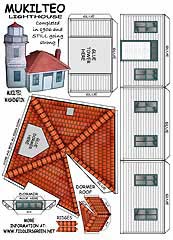
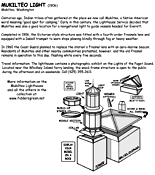

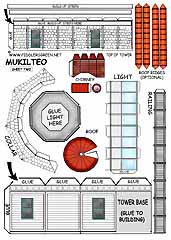
Mukilteo, WA - $$4.95
Centuries ago, Indian tribes often gathered at the place we now call Mukilteo, a Native American word meaning "good spot for camping." Early in this century, the Lighthouse Service decided that Mukilteo was also a good location for a navigational light to guide vessels headed for Everett.
The Mukilteo Lighthouse, Mukilteo Washington
 Centuries ago, Indian tribes often gathered at the place we now call Mukilteo, a Native American word meaning "good spot for camping." Early in this century, the Lighthouse Service decided that Mukilteo was also a good location for a navigational light to guide vessels headed for Everett. Completed in 1906, the Victorian-style structure was fitted with a fourth-order Fresnels lens and equipped with a Daboll trumpet to warn ships plowing blindly through fog or heavy weather.
Centuries ago, Indian tribes often gathered at the place we now call Mukilteo, a Native American word meaning "good spot for camping." Early in this century, the Lighthouse Service decided that Mukilteo was also a good location for a navigational light to guide vessels headed for Everett. Completed in 1906, the Victorian-style structure was fitted with a fourth-order Fresnels lens and equipped with a Daboll trumpet to warn ships plowing blindly through fog or heavy weather.
In 1960 the Coast Guard planned to replace the station's Fresnel lens with an aero-marine beacon. Residents of Mukilteo and other nearby communities protested, however, and the old Fresnel remains in operation to this day, flashing white every five seconds.
The Mukilteo Lighthouse
 Established
in 1906, this lighthouse is an octagonal, 30-foot wood tower attached
to a fog signal building. Overlooking the sound near the ferry
landing in historic Mukilteo, the lighthouse is still active with
its original Fresnel lens. The Coast Guard maintains a photographic
exhibit of Puget Sound lighthouses at Mukilteo Station for visitors
to see on weekends.
Established
in 1906, this lighthouse is an octagonal, 30-foot wood tower attached
to a fog signal building. Overlooking the sound near the ferry
landing in historic Mukilteo, the lighthouse is still active with
its original Fresnel lens. The Coast Guard maintains a photographic
exhibit of Puget Sound lighthouses at Mukilteo Station for visitors
to see on weekends.
Mukilteo Light abreast the town of Mukilteo, has been in existence since 1906, marking the waterway at Point Elliot on the east side of Possession Sound along the sea road to Everett.
Designed by C. W. Leick, the frame lighthouse is located on an historic tract of land where Governor Isaac Stevens of Washington Territory signed an important peace treaty with the Indians in 1855 A similar treaty was signed in the same year at Point No Point Involved were 1,000 Indians from the Chimacum, Skokomish and Clallam tribes who agreed to end hostilities.
A familiar scene to countless persons, Mukilteo Lighthouse shares its historic corner with sports fishermen and ferryboat users. The Washington State Ferry System operates units of its fleet on the busy Mukilteo-Whidbey (Columbia Beach) Island route, the ferry dock within a stone's throw of the watch tower.
 For a time
the Coast Guard planned to demolish the classic lighthouse and
replace it with a navigation light on a pole. Civic intervention
put the economy move on the skids and the lighthouse will continue
to stand just where it has always been even if it is eventually
deactivated. Originally there were two keepers dwellings on the
tract, but both have been removed. There was also a former windmill
for pumping water, but it too has disappeared.
For a time
the Coast Guard planned to demolish the classic lighthouse and
replace it with a navigation light on a pole. Civic intervention
put the economy move on the skids and the lighthouse will continue
to stand just where it has always been even if it is eventually
deactivated. Originally there were two keepers dwellings on the
tract, but both have been removed. There was also a former windmill
for pumping water, but it too has disappeared.
One of the longer tours of duty at Mukilteo was put in by Coast Guardsmen Vivian R. Corrie, who tended the light from 1946-1960. The station has been automated for the past several years, maintenance crews being dispatched on demand.
On March 2, 1906, the Everett Morning Tribune reported in bold headlines: "Lamp Lit in New Mukilteo, Tower ... Best Light House in Entire Puget Sound District." The Tribune reporter wrote excitedly, "last night ... dozens of people curiously watched the glimmer of the lamp as it shot its beam of yellow light in the direction of the city at regular intervals."
Some fifty years earlier, in January 1855, Isaac Stevens, the Governor of Washington Territory, had met with Native Americans at Muckl-te-oh to sign a treaty with leaders of twenty tribes. The town later founded here was originally called Point Elliot. In 1862, however, store owner J. D. Fowler became the town's postmaster and changed its name back to Mukilteo, which means "good camping ground."
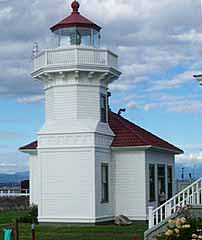 Although
Point Elliot (called Elliot Point on modem charts) did not present
a hazard like other lighthouse sites, the Lighthouse Board in
1901 decided that "a light and fog signal would be of much
benefit to navigation." Large vessels turned at the point
on their way to Everett's harbor, while others traveled up Possession
Sound and Saratoga Passage, ."which route is much frequented
by the smaller boats running out of Tacoma and Seattle."
Although
Point Elliot (called Elliot Point on modem charts) did not present
a hazard like other lighthouse sites, the Lighthouse Board in
1901 decided that "a light and fog signal would be of much
benefit to navigation." Large vessels turned at the point
on their way to Everett's harbor, while others traveled up Possession
Sound and Saratoga Passage, ."which route is much frequented
by the smaller boats running out of Tacoma and Seattle."
Construction of the station began in 1905, and when completed it consisted of two keepers' dwellings and a thirty-eight-foot-high octagonal tower attached to a fog signal building. Compressors on the building's main floor powered a Daboll trumpet.
The light source for the fourth-order Fresnel lens, according to the Tribune account, was "nothing more than a small circular burner, similar to an ordinary Rochester parlor lamp." The reporter described the two keepers' dwellings as modem in every respect - equipped with steam heat, baths, and everything to be found in any up-to date house. Next to one dwelling stood a windmill to pump water from a well.
The Tribune also noted that the appointment of Peter N. Christiansen as principal keeper "comes as a reward for his faithful services." The reporter concluded that "the light station is open to visitors at all times, who will find Keeper Christianson [sic] both hospitable and entertaining."
Christiansen was born in Norway and went to sea at age fourteen. He served in the Merchant Marine for eleven years and in the United States Navy for ten years, then joined the Lighthouse Service. In 1893, he became the first assistant keeper at Turn Point Lighthouse. While there, he and principal keeper Edward Durgan rescued men from the vessel Enterprise caught in a severe February storm in 1897. Both received certificates of merit for their heroic efforts.
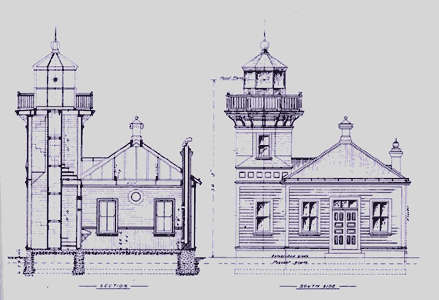
After thirty-one years with the Lighthouse Service, Christiansen died in 1925 while at the Mukilteo Lighthouse. His wife served as keeper until Edward A. Brooks took over. While Brooks was keeper in 1927, electricity was installed at the station, and the kerosene lamp was replaced by a Thomas Edison bulb, the largest and brightest bulb then available.
 Brooks
was replaced by Ray Dunson in 1937. Dunson, who had earlier served
at Smith Island, stayed at Mukilteo until 1939, when the Coast
Guard took over the station. In the 1960s, the Coast Guard planned
to replace the Fresnel lens with a modern optic. Residents of
Everett and Mukilteo protested, however, and the Fresnel lens
stayed. It and a modern fog signal were automated in 1979.
Brooks
was replaced by Ray Dunson in 1937. Dunson, who had earlier served
at Smith Island, stayed at Mukilteo until 1939, when the Coast
Guard took over the station. In the 1960s, the Coast Guard planned
to replace the Fresnel lens with a modern optic. Residents of
Everett and Mukilteo protested, however, and the Fresnel lens
stayed. It and a modern fog signal were automated in 1979.
One of the last coast guardsmen to serve as resident keeper at the station was Kurtis Betz from Winnemucca, Nevada. Between 1986 and 1990, he maintained the grounds and the lighthouse, and gave tours. Betz became interested in the station's history and collected artifacts from its past, some of which can be seen in the fog signal room. The displays include copies of the 1855 treaty, Christiansen's certificate of merit, and the recently acquired Fresnel lens from Oregon's Desdemona Sands Lighthouse.
In 1991 the Coast Guard leased the lighthouse - which by then was on the National Register of Historic Sites - to the city of Mukilteo. The two keepers' dwellings were leased to the city in 1996.




